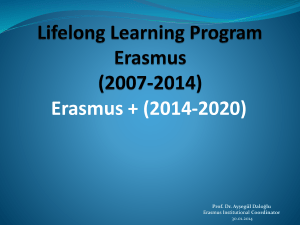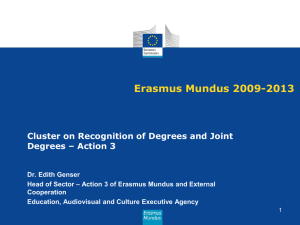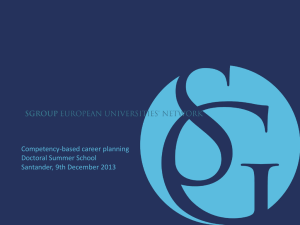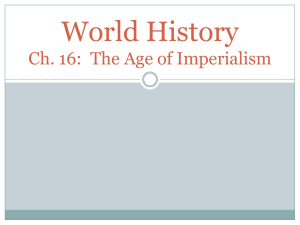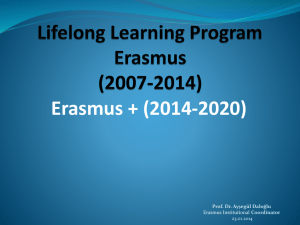EM Call for Proposals 2011
advertisement
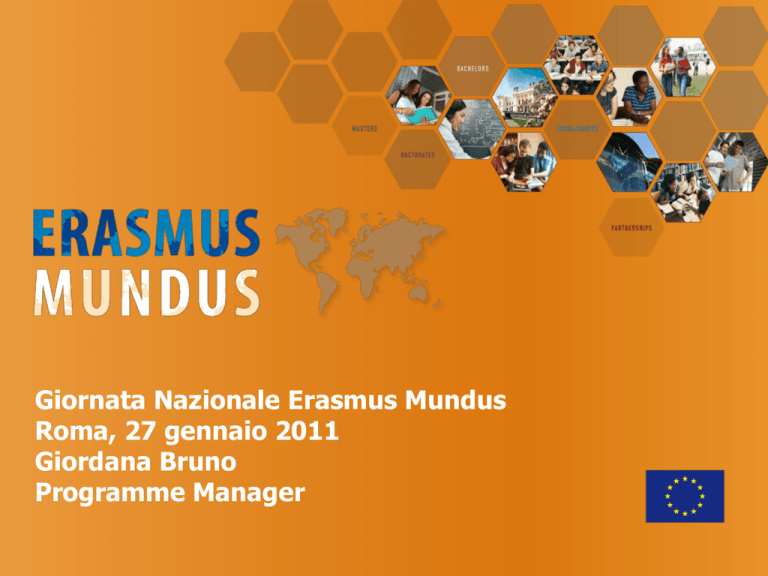
Giornata Nazionale Erasmus Mundus Roma, 27 gennaio 2011 Giordana Bruno Programme Manager Erasmus Mundus Call for Proposals 2011 Education, Audiovisual and Culture Executive Agency Erasmus Mundus aims • Promote European higher education • Improve and enhance students’ career prospects • Promote intercultural understanding through cooperation with third countries • Contribute to the sustainable development of third countries in the field of higher education EM Call for Proposals 2011 • One programme, three actions = one Call • Call published 16 December 2010 • Deadline 29 April 2011, Selection July 2011 For Action 1 Proposals: 12h00 !! (Central European Time) • Key documents: – Programme Guide – Guidelines for Applicants (Action 2) – Call for Proposals Key documents: Erasmus Mundus Programme Guide • For project beneficiaries and scholarship grantees • Programme objectives, activities, eligibility criteria, conditions for support • Valid for 2009-2013 period • For use with individual Calls for Proposals documents, Guidelines for Applicants (Action 2) and Application Form instructions Key documents: Erasmus Mundus Guidelines (Action 2) • • • • • Lists geographical lots Budget per lot minimum mobility flows Thematic priorities (disciplines) Specific criteria for partners/partnerships Types of mobility funded and duration Key documents: Call notice - Official Journal C 341, 16.12.10 • Brief programme description • Targets and/or budget per Action • Summary of award criteria • Priorities under Action 3 • Submission deadlines Action 1 – Joint Programmes Action 1 – facts & figures so far • 123 Masters courses (EMMCs) with scholarships in 2011 • 24 Joint Doctorates (EMJDs) • 380 different HEIs as full partners in these 147 programmes • 10.111 student scholarships 20042010 • 1614 scholar scholarships 2004-2009 EM Call 2011 – Action 1 • Action 1 Call targets – EMMCs: 10 new Masters & up to 22 renewals – EMJDs: 10 new Doctorates • PDF version of application form & Instruction document now on line • E-forms to be used for final applications • Summary sheets (on paper version) by 31 March 2011 • Application Deadline: 29 April MIDDAY ! (Central European Time) An EM Joint Programme must (1): 1. be coordinated by an eligible EU HEI applicant; 2. have min. 3 different EUR countries represented as partners (EU / EEA) - additional partners may be from EUR or third countries; 3. be an integrated programme in all its aspects; 4. be fully developed at application stage and ready to run for 5 consecutive editions as summer 2012 5. be based on consortium agreement signed by the governing bodies of the partner HEIs (signed before signature of the first specific grant agreement); 6. include a mandatory mobility component in at least 2 EUR countries; An EM Joint Programme must (2): 7. be fully recognised (by summer 2012 at the latest); 8. lead to the award of a double, multiple or joint degree (the latter will be favoured) 9. provide for the use of national European languages 10. attract and recruit top class students / doctoral candidates / scholars worldwide 11. provide high quality services to enrolled candidates (visa / residence permit support, mandatory insurance, support to family and special needs) 12. sign agreements with students / doctoral candidates on rights and obligations of each party EM Joint Programmes: Contractual and Financial conditions (1) If selected for funding 1. Framework Partnership Agreement covering 5 consecutive editions (5 to 8 years, in accordance with the length of the joint programme) 2. 5 yearly Specific Grant Agreements covering the financial support for each of the 5 editions: – Management of the joint programme: flat rate amount (30,000 € for EMMCs, 50,000 € for EMJDs) per edition – Fixed number of Individual scholarships / fellowships (exact number fixed yearly – autumn year “n-1” - in accordance with the “seniority” of the joint programme) • Two types of scholarships / fellowships – Category A: third country individuals, not resident, and have not carried out their main activity in Europe for more than 12 months over the last 5 years – Category B: any individual who does not fulfil category A requirement EM Joint Programmes: Contractual and Financial conditions (2) Different types of scholarships / fellowships • For students or doctoral candidates – Category A: third country individuals, not resident, and have not carried out their main activity in Europe for more than 12 months over the last 5 years – Category B: any individual who does not fulfil category A requirements • For scholars in Joint Programmes at masters level – Non European: scholars enrolled in any non European HEI – European: scholars enrolled in partner EUR HEIs, under the condition that the consortium includes student mobility to non EUR partners Joint Programmes at masters level (EMMCs) : Specific features (1) • All partners must be able to act as host institution and deliver part of the curriculum – min. 20 ECTS (for one year EMMCs) or 30 ECTS (for longer EMMCs) for European HEIs – min. 15 ECTS for third country HEIs • The EMMC must last between 1 (60 ECTS) and 2 academic years (120 ECTS) – final examination results to be known at the latest in October of the year in which the EMMC finishes Joint Programmes at masters level (EMMCs) : Specific features (2) • The consortium is free to define its participation costs (/tuition fees) amounts but: – amounts must cover all common mandatory costs and be transparent / clear to student applicants – there can be two different amounts for EUR and non-EUR students – The scholarship includes a max. contribution these costs: EUR 8000 / year (Cat. A) - EUR 4000 / year (Cat. B) – Fee waivers for amounts in excess of this max. contribution are considered as good practice. • Non-EUR Scholar scholarships are offered to all consortia (number varies in accordance with size and composition) • EUR Scholar scholarships are offered only if the programme includes student mobility outside Europe EMMC financial contribution Contribution to EMMC running costs Individual Scholarships I Contribution to travel and any other types of personal costs II Contribution to participation costs (incl. insurance) III Monthly allowance € 30 000 / course edition Category A Category B € 4 000 / per year € 3 000 - only if mobility to nonEUR partner Max € 4 000 / semester Max € 2 000 / semester € 1 000 / month € 500 / month € 1 200 / week for a min of 2 wks and max. of 3 mths per scholar IV Living allowance (incl. travel costs) TOTAL Scholars € 24 000 / per year € 10 000 per year € 14 400 for a 3month stay (+ € 3 000 if travel) (max / scholar) EMMC award criteria • A1: Academic quality – course content (30%) • A2: Course integration (25%) • A3: Course management, visibility and sustainability (20%) • A4: Students’ services and facilities (15%) • A5: Quality assurance and evaluation (10%) Published on the website with specific questions to help applicants formulate their answers Joint Programmes at Doctoral Level (EMJDS) : Main Features (1) • Based on the EMMCs model and on the experience of Marie Curie fellowship – Marie Curie is focused on grantees individual research – EMJDs puts more emphasis on structured interuniversity cooperation models and on the implementation of integrated joint doctoral programme • Double objective – Shape doctoral studies in the EHEA (promoting innovative models of joint governance between the HEIs, research and professional sectors – Support researchers from EUR and non-EUR countries in a framework of excellence Joint Programmes at Doctoral Level (EMJDS) : Main Features (2) • Organisations other than HEIs can be formal partners of the consortium if they – provide teaching, training or research opportunities and/or – recruit, employ, host doctoral candidates • EMJDs of 3 or 4 years duration BUT fellowships for max 3 years • For each EMJD edition – Start individual research project at the latest in March of the acad. year concerned – Candidates final results (/thesis defence) at the latest in October of the fourth year • Training / research for a minimum total of 6 months in at least two of the consortium EUR countries. Joint Programmes at Doctoral Level (EMJDS) : Main Features (3) • Clear definition and justification (needs analysis / added value) of the thematic area(s) covered by the EMJD • Recruitment of doctoral candidates under employment contracts (unless prohibited by national regulation) • Follow the principles of the European Charter for Researchers and the Code of Conduct for the recruitment of Researchers • Free determination of participation costs but – must be transparent and clear to potential candidates – 2 different fixed amounts for laboratory and non laboratory based research Joint Programmes at Doctoral Level (EMJDS) : Main Features (4) • Employment contracts is the EMJD recruitment method that guarantees adequate and equitable social security provisions: - Sickness and parental benefits - Health and accident insurance - Pension rights and unemployment benefits and is in accordance with existing national legislation and with national or sectoral collective bargaining agreements • An EMJD is supposed to be laboratory-based if the research projects carried out by the doctoral candidates require the usage of expensive equipment/material, the execution of external fieldwork or involve particularly high costs that would exceed the 300 EUR/month included in the fellowship amount for « non-laboratory-based » research projects EMJD fellowships Contribution to EMJD running costs 3 years Doctoral Fellowship I II Travel, installation and other personal costs EMJD participation costs € 50 000 / EMJD edition (/cohort) Category A Category B € 7 500 € 3 000 (if mobility to a thirdCountry partner) •€ 300 per month (€ 10 800 for 36 months) for non-laboratory-based EMJDs or • € 600 per month (€ 21 600 for 36 months) for laboratory-based EMJDs •€ 2 800 per month (i.e. € 100 800 for 36 Fixed living allowance (36 months months) for an employment contract in total) III •€ 1 400 per month (i.e. € 50 400 for 36 months) for a stipend Maximum fellowship amount Between EUR 61 200 and EUR 129 900 (depending on category, lab., or type of recruitment) EMJD award criteria • Academic and research quality (25%) • Partnership experience and composition (25%) • European integration and functioning of the programme (20%) • Provisions for candidates awarded an EMJD fellowship (15%) • Management, sustainability and quality assurance (15%) Award criteria published on web with questions to help applicants formulate their answer EM Joint Programmes - Key Words 1. 2. 3. 4. 5. 6. Excellence Integration/Jointness Commitment Sustainability Employability Transparency EM Joint Programmes : How to stand out from the Crowd ? • • • • Solid integrated consortium Solid / coherent learning/research programme Strong links with society needs (in and out EU) Strong academic/research quality and innovation potential Consult information available on good practices (see EM Joint Programmes usefull links) Get advise for experienced colleagues and EM National Structures Action 2 - Partnerships Action 2 Partnerships - cooperation • Large partnerships between higher education institutions in EU and third countries in a specific region • Countries / regions covered by the EU’s external co-operation instruments • Erasmus-style cooperation mechanisms, transfer of know-how • Definition of priorities according to the needs of third countries involved Action 2 – Mobility • Scholarships of varying length (1 month to 3 years) • Bachelor, master, doctorate and postdoctorate students and HE staff (training, teaching, research activities) • Mobility not linked to specific programmes • Special attention paid to socioeconomically disadvantaged groups and populations in a vulnerable situation (Strand 1 only) Action 2 and External Cooperation Window to date 116 partnerships selected, 2007 - 2010 2,100 participations by 822 different HEIs 256 EU, 566 non-EU 14,000 mobilities to date (2007-2009 selections) 5,500 mobilities planned in partnerships selected in 2010 Action 2 shape and finance • Composition – At least 5 European HEIs from at least 3 EU countries – At least 1 HEI from each country of the Lot (S1) – At least 3 HEIs from two countries of the Lot (S2) Check the specific lot for details • Maximum eligibility period: 48 months • Partnership management flat rate = EUR 10,000 x number of partners (max EUR 200,000) • Individual scholarships using flat rates cover: – – – – Travel Subsistence costs Fees Insurance and visa costs Action 2 individual mobility • 5 possible levels of higher education: – Undergraduate – Masters - Doctorate - Post-Doctorate – Staff • Variable length mobility: – 1 – 36 months for both degree-seeking and other students • 3 target groups – Target Group 1: students/staff from partners institutions – Target Group 2: other nationals from third countries – Target Group 3: national of third countries in lot in vulnerable situation Action 2: common & specific elements • Common to all Action 2 lots – – – – – A range of target groups for mobility A range of duration for mobility Up to 5 levels of higher education covered Project must start operations in year of selection (year ‘n’) Mobility may start in different ‘cohorts’ throughout partnership life • Specific to individual lots (See Guidelines) – – – – Which target groups covered by mobility Which levels of higher education covered Thematic fields of study Partnership composition Action 2 individual mobility • Strand 1 – TG 1 at least 50% of individual mobility – Third-country mobility at least 70% of individual mobility – European mobility maximum 30% of individual mobility (ENPI and IPA) – No mobility for Europeans under DCI or ACP • Strand 2 – Only TG 1: no undergraduate level – European mobility at least 60% of individual mobility – Third-country mobility to Europe no higher than 40% of individual mobility EM Call 2011 – Action 2 What’s new in 2011? • New distribution of lots in Mediterranean • Libya newly-eligible (Lot 1) • Student selections may be in up to three annual cohorts • Extended duration for – Masters: up to 24 months – Doctorates: up to 36 months EM Call 2011 – Action 2 Action 2: Strand 1 • 16 Lots for countries covered by ENPI, DCI, EDF, IPA • 38 projects expected • Total budget EUR 94.5 million • Mobility for at least 3,335 individuals Action 2: Regions and Lots (Strand 1) Budget (EUR) and min. scholarships S. Med, E.Europe & Russia 36M, 1090 sch 3 2 3 5 W. Balkans 12M, 510 sch 1 1 1 1 1 2 1 1 ACP 6M, 190 sch South Africa 2.8M, 60 sch Asia Regional 20 M, 900 sch Argentina 5.2M, 210 sch 2 +2 n Central Asian Republics 10 M, 300 sch 5 5 2 Middle East 2.5M, 75 sch = n° of projects to be selected DCI EDF ENPI IPA Action 2 award criteria: Strand 1 1: Relevance (25%) 2: Quality (65% total) – 2.1. Partnership composition and cooperation mechanisms (20%) – 2.2. Organisation & implementation of mobility (25%) – 2.3. Student/staff facilities and follow-up (20%) 3: Sustainability (10%) EM Call 2011 – Action 2 Action 2: Strand 2 (Industrialised Countries Instrument) • • • • 4 Lots for countries covered by ICI 4 projects expected Total budget EUR 6.3 million Mobility for at least 140 individuals Action 2: Regions and Lots (Strand 2) US & CAN EUR 1 m 20 sch Gulf EUR 2.1 m 50 sch SE Asia EUR 1.4 m 35 sch AUS, NZ, JPN EUR 1.9 m 35 sch ICI EUR 6.3M, 140 scholarships 40 Action 2 award criteria: Strand 2 1: Relevance (25%) 2: Contribution to excellence (25%) 3: Quality (50% total) – 3.1. Partnership composition and cooperation mechanisms (15%) – 3.2. Organisation & implementation of mobility (20%) – 3.3. Student/staff facilities and follow-up (15%) Action 3 Action 3 • Promotion projects and “clustering” activities • Information grants for Erasmus Mundus National Structures • Erasmus Mundus Students and Alumni Association (EMA) • Studies Action 3 results to date: promotion projects • 54 projects selected under former A4 (2004-2008) • Total budget: € 13.36 M • 8 projects selected under A3 (2010) • Total budget: € 2.32 M Action 3 results to date – Projects focused on specific fields: • Promotion of Education Higher Education to the world • Doctoral studies & research • Services for international students & doctoral candidates • Quality Assurance • Recognition of degrees & joint programmes development • Promotion of specific academic disciplines Action 3 results to date – Projects focused on specific regions: • Asia (16) • Africa (11) • Europe (10) • Latin America (20) • North America and Industrialised Countries (14) EM Call 2011 – Action 3 • Budget EUR 1,3 million • Target: 6 projects • Indicative project size: from EUR 100.000 to 350.000 • European co-financing to max 75% • Project duration: 12 – 36 months • Min. 3 European and 1 Third Country partner EM Call 2011 – Action 3 (open call only) Action 3 priority areas - projects aiming to: • Promote European HE in certain geographical areas with priority to the less-represented in Erasmus Mundus (e.g. Africa, industrialised countries) • Improve services for international students and doctoral candidates • Address the international dimension of Quality Assurance • Strengthen relation between HE and research in Europe • Promote European study opportunities for doctoral candidates • Promote the Erasmus Mundus programme towards European students EM Call 2011 – Action 3 Project requirements • Clear European dimension and wide geographical scope • Clear international (third-country) dimension • Must contribute to fostering intercultural dialogue and mutual understanding between cultures • Ensure no overlap with other EU programmes for higher education Action 3 award criteria 1. Relevance to the EM programme (25%) 2. Expected impact to help enhance attractiveness of European HE worldwide (25%) 3. Arrangements for dissemination of results and experiences, quality assurance and plans for sustainability and long-term exploitation of results (15%) 4. Consortium composition and cooperation mechanisms (15%) 5. Work plan and budget (20%) Tips and advice for applicants • Respect of all formal eligibility criteria (e.g. deadline, signatures etc.) • Coverage of all questions of the application form • Concrete and consistent comments • All the required information should be in the application form (experts are not obliged to consult the annexes) • Clear information about the role of the coordinator and the partners in the consortium • Provision of supporting information where necessary • Use of annexes only for additional information • Do not assume: what is in your mind and not in the application cannot be assessed • Balanced partnership is essential (all partners within and outside Europe should play an active role and be committed to the project) • Coherent and realistic budget and workplan Characteristics of a good proposal • Coherence (contradictions are lethal!) • Simplicity: a few well chosen words can often replace a long and vague explanation • Evidence based : use examples, justify your needs analysis, bring proofs • Clarity: the expert should not end his/her reading with an headache • Explicit: nothing should be taken for granted • Rigour: an application is a commitment to carry out the project and forms the basis for the Agency’s monitoring • To the point: stick to what is asked • Completeness: ensure you have followed all the submission instructions of the application form Erasmus Mundus selection process Action 1 Action 2 Action 3 EACEA: Eligibility and selection criteria National Structures: Eligibility EU HEIs Recognition degrees EU Delegations: Eligibility 3C HEIs EU Delegations: Eligibility 3C HEIs Relevance regional priorities External experts: Assessment of proposals Selection Board Evaluation Committee Selection Decision Assessment by external experts • Selected by Agency after Call for expression of interest – http://eacea.ec.europa.eu/about/call_experts/ call_experts_2007_en.php • Two individual assessments are consolidated. If significant divergence, a third assessment • Expertise in international HE cooperation – plus thematic expertise for Actions 1 & 3; – geographical expertise for Action 2 • Summary sheets (Action 1) help pre-select experts in correct fields Erasmus Mundus website: http://eacea.ec.europa.eu/erasmus_mundus/index_en.php Infoday site (with presentations and – later - videos) http://eacea.ec.europa.eu/erasmus_mundus/events/infoday_2011_en.php

